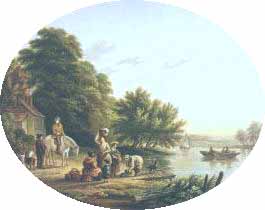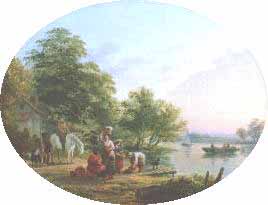Feature July 2012
John Anthony Puller and the Le Blond Connection
It was not until May 1997, when two oil paintings by J A Puller appeared at an auction in Leeds, that we realised at least some of the well know Le BLond oval prints were in fact copied from Puller's original paintings.
Since then, many other paintings by John Anthony Puller have been identified that are also practically identical to the ovals making it most likely that all of Abraham Le Blond's ovals were copied from Puller's paintings.

 Le Blond's print of 'Waiting at the Ferry' on the left compared to Puller's painting right
Le Blond's print of 'Waiting at the Ferry' on the left compared to Puller's painting right
As Le Blond produced so many prints from John Anthony Puller's paintings it seems likely that they must have had some formal arrangement although no evidence of this has yet been found.
John Anthony Puller, the son of Joshua and Elizabeth Puller, was born on 22 January 1799 in Bethnal Green, London. His paintings were first recorded in 1821 when he exhibited two landscapes in oils at the Royal Academy.
The following year he began exhibiting at the British Institution and in 1825 at the Royal Society of British Artists. J A Puller frequented these three institutions, exhibiting over 170 paintings in 40 years.
His early works were landscapes, often as large as 30 x 25 inches. Within ten years he was producing mainly genre scenes and later we find many of these are oval oils on board which at 7 x 5 inches are about the size of Le Blond's ovals.
A lot of these ovals are identical to Abraham Le Blond's ovals with the same titles. Many more are similar compositions suggesting that Puller's paintings themselves were popular and he exploited this popularity by painting different versions of each subject.
Puller working life was spent in the East End of London with addresses in Mile End, Shoreditch and the Hackney Road.
John Anthony Puller exhibited his last painting in 1867 less than a year before his wife Mary died. He later moved to Clapham and died at the home of his niece in Forest Hill on 30 November 1886, a few weeks before his 88th birthday.